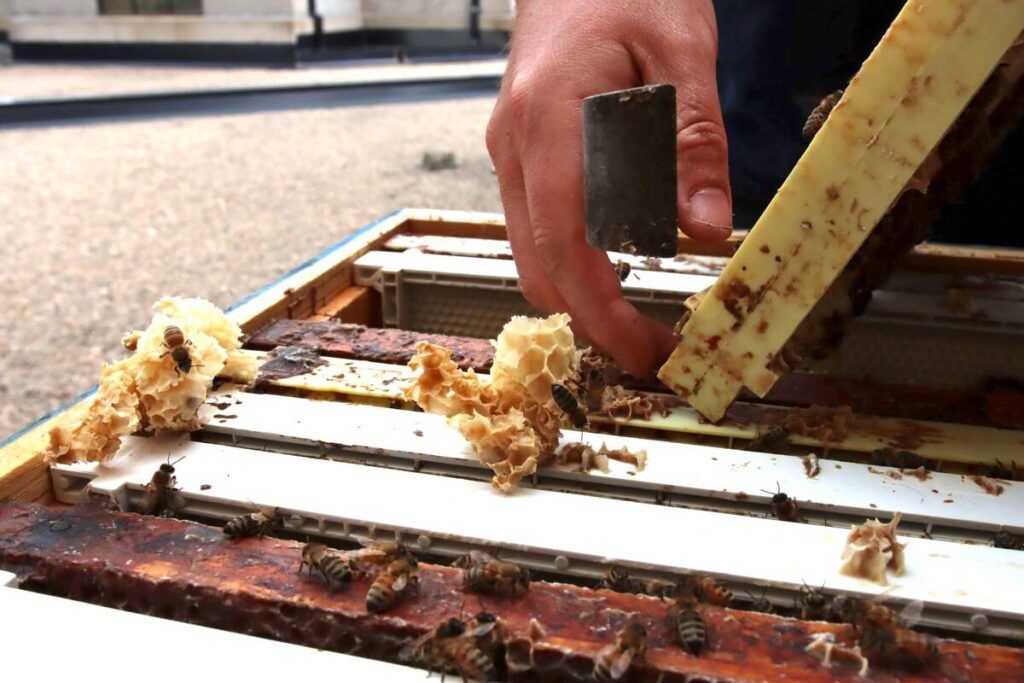Apiarists keeping an eye on smoky skies

Ontario apiarists are keeping a close eye on their bee hives as smoke from wildfires in western Canada are blanketing the province and leading to air quality warnings.
Although not much is known about how smoke from wildfires affects bees, an Ontario beekeeper says there are several precautions apiarists can take to minimize health risks to the bees, as well as to themselves.
Why it matters: Smoke from wildfires could affect the health of bees and beekeepers.
“At this point we haven’t noticed an impact on our bees from the wildfires in western Canada,” said Steve Moore, president of the Ontario Bee Association.
Read Also

Farm and Food Care Ontario gets $597,000 in program funding
Farm & Food Care Ontario (FFCO) gets a $597,000, three-year funding agreement from the Ontario Ministry of Agriculture, Food and Agribusiness (OMAFA) to enhance and expand consumer outreach and farmer and agri-business training.
But as former residents of a region prone to wildfires -Sioux Lookout- Moore said he and his wife take precautions during wildfire season to avoid putting any additional stress on their hives.
“During wildfire season I was always extra cautious with my smoker,” he said. “I would make sure I carried water to the apiary with me in case a spark from my smoker needed to be dealt with. I would be sure to use a bundle of green grass as a spark arrester at the top of my smoker, and I would always take my smoker home and dispose of the ashes where I was able to keep an eye to make sure they were truly extinguished.”
Like other agricultural animals, Moore believes it is important to have an evacuation plan if beekeepers are in close proximity to a wildfire.
He said it can take time to find an alternative location for an apiary and move the hives. “Many beekeepers will have a couple of backup apiary locations in mind in case they have to move their bees, but in a wildfire, a beekeeper might have to move all their apiaries or move them unusually far to be out of the risk of fire,” he said.
“Having a plan in place and knowing when to implement it is always worthwhile.”
Presently, Moore says there is not a lot of research on the effect of forest fire smoke on honeybees.
A study by Australian-based Agriculture Victoria found that if wildfire heat causes cooling to fail within hives, the queen and worker bees can suffer heat stress, and beeswax combs and honey may melt.
Additionally, the study found that heat-stressed colonies can take months to recover to full honey production and pollinating potential. The study noted that colonies with partial meltdown of combs can rebuild combs over time; however, most colonies suffering total meltdown of combs are unlikely to recover.
“I did not notice any unusual behaviour in my bees during the bad fire season we spent up in Sioux Lookout,” he said , noting that the bigger risk associated with smoke from wildfires may be to the beekeeper themselves.
“Beekeeping in the summer is hot and heavy work, and if the air quality is poor, it could cause some health concerns for some beekeepers. Health Canada recommends limiting exposure to wildfire smoke. Beekeepers could do this by checking air quality and trying to time work for the days when air quality is best,” he advises.
Ensuring the health of bees during wildfire season is a collective effort, according to Moore. He said that farmers already do a lot to support bees and beekeepers.
“Beekeepers always appreciate it when farmers plant crops and cover crops that provide good forage for bees. Floral diversity is always welcome.”
Moore said “when I bush hog the roadside along our farm to keep the brush from getting out of hand, I try to do it in October or November after the goldenrod and aster bloom has finished. It still lets me keep the brush from growing in while also giving the bees a wonderful nectar source,” he said.
Moore is confident that most farmers are very respectful of bees and try to choose pesticides that are least likely to harm bees and apply those pesticides when bees are least active.
“The rural community is pretty good at looking out for each other, and the key is that we keep checking in, especially if there are threats like wildfires in the areas folks are operating in,” he said.
For updates on wildfire conditions across Ontario, visit the Forest Fire Info Map, managed by the Ministry of Natural Resources: https://www.lioapplications.lrc.gov.on.ca/ForestFireInformationMap/index.html?viewer=FFIM.FFIM
Source: Farmtario.com


